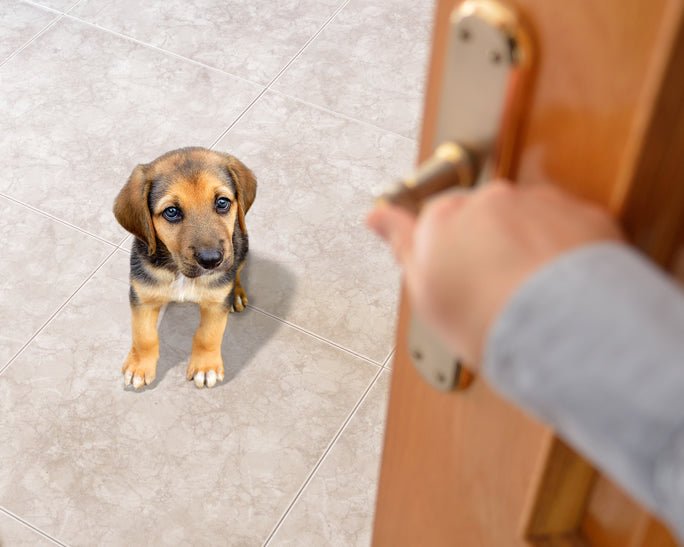![]() Listen to the Podcast
Listen to the Podcast
Yikes! The gate blew open. Where is the dog? A delivery at the front door. Oh no, the dog ran out. Today we're going to talk about threshold training with your dog. This is an important concept and something I teach to all of my dogs when they are young. They are never allowed to move through the front door or the backyard gate without my say so!
This is a big fear of mine. What happens if the dog slips out the back gate because the wind has blown it open, you may not be there to stop the dog from leaving. It's great to have some measures in place to put the responsibility on the dog. How nice to know that in your absence, they will make the choice to stay put and safe!
Where to Use It
Front Door/Back Gate
In my opinion, training a dog to never cross these thresholds without permissions should be high on everyone's priority list. A little bit of training goes a long way when it comes to safety and a dog running out the front door can be a recipe for disaster.
Car Door
This is another important training opportunity. Teach your dog to wait for a release before jumping out of the car. Don't let them assume that the door opening is their permission to jump out. You never know what dangers may await them. Having them wait will allow you to check the area for dangers, hook up a leash and release the dog on your time.
The Dog Thief
One of our Facebook followers brought this point up to us recently and I thought it was very valid! When dogs are stolen from yards, the thief often just opens the gate and leads the dog away. Teaching your dog to only break the threshold of a gate on your release word could prevent them being stolen one day!
Other Imaginary Barriers
My boy Reggie is a dog I refer lovingly to as a "walking stomach". He LOVES food more than anything! When I'm cooking, he can be downright dangerous if he's allowed in the kitchen as he follows food very closely and quickly becomes a tripping hazard. It was clear to me early on that I had some work to do. I taught Reggie to remain just outside of the kitchen door. He is not allowed to enter without permission. This is safe and convenient for me. When I want to allow him in the kitchen, I simply give him permission with a release word. The rest of the time, he is simply not allowed in.
Think about the layout of your house and where this sort of barrier training would benefit you. Remember that it's not all or nothing. Just like with Reggie in the kitchen, you can allow access by inviting your dog in, but the default behaviour with threshold training is that they never cross it without permission.
How to Teach it
Practise each step several times. Don't move on until your dog is proficient at the current step.
Teaching the Stop & Sit
You'll only need your dog to understand the sit cue and a release word to start this training. Start by bringing them, on leash, to the barrier you're working on. Once you're there, cue them to sit. Reward if they do and place them in the sit if they don't. After you've rewarded them, release.
Here is a video that shows this process:
Teaching the Stay
Next, teach remaining in place for longer durations. Reward on a random schedule and if they leave the sit before you've given your release word, put them back. It's important for them to know when they make a mistake as well as when they are right! You don't want to be rough, but you do need to clarify both right and wrong to help your dog learn.
Proofing the Stay
Proof with as many distractions as you can think of. The more you practise and proof, the more your dog will understand how to make the right choice when they are asked to. Your dog will learn through trial and error. Start with light distractions, always giving timely feedback to your dog. Build on distractions until your dog can make the right choices despite the toughest things you might use to test them.
Fade the Cue
All of this work with proofing is what will cement the concept of your dog making the choice to hold position behind the threshold. We also want them. to understand how to stop there when we haven't asked. Once your dog is proficient at all of the previous steps, start to expect them to offer the sit at threshold and reinforce that heavily.
Expecting your dog to offer a behaviour means that you are not cuing them in any obvious manner, rather you are waiting until they offer the expected behaviour and then you can capture it with a marker (yes or click) and reward. Initially, you may have to wait several seconds (or longer) before your dog might offer the sit, but be patient and it will come. Resist the urge to help them if they aren't getting it right away. If you help them now, they'll learn to wait for that help all of the time. If you've done the work above and built value for the sit and stay, they will be thinking about how to earn rewards in this situation and will come back to what got them rewarded previously (reinforcement history).
At the stage where they are offering the sit with you stopping at the threshold, you can work on fading the need for the leash and your presence. This can be done by walking to the threshold and reinforcing right or wrong. Then walking by the threshold and doing the same. When I get to this stage, if my dog continues with me, I will simply stop them with a negative verbal marker, I use a light 'oops'. Then I will wait until I get the sit and praise once I do, but I will hold off on giving my dog a reward until they offer the sit from motion.
Proofing the Stop
Change your body position in relation to the dog so that you can put more responsibility on them to make the choice not to cross the threshold independently from you. Work on moving away from their side and keeping the same expectation regardless of where you are in the picture.
Now this step to make this exercise picture perfect. Make sure you are clear and consistent with your rewards, fixes AND with your release cue. Work through proofing on an escalating scale as you did with your other steps. The more you proof, the stronger your dog's understanding will be.
Take this training to any threshold you want your dog to respect and it will pay off when you see your dog making the choice to not cross it without your permission.
As always, Happy Training!

